The Spectrum Analyzer Market is estimated to be valued at USD 1.8 billion in 2025 and is projected to reach USD 4.2 billion by 2035, registering a compound annual growth rate (CAGR) of 9.0% over the forecast period.
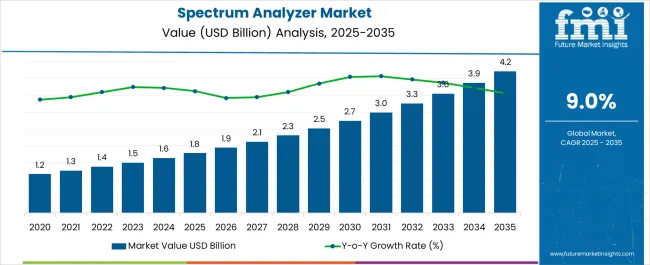
| Metric | Value |
|---|---|
| Spectrum Analyzer Market Estimated Value in (2025 E) | USD 1.8 billion |
| Spectrum Analyzer Market Forecast Value in (2035 F) | USD 4.2 billion |
| Forecast CAGR (2025 to 2035) | 9.0% |
The Spectrum Analyzer market is experiencing robust growth, primarily driven by the rising demand for precise frequency measurement and monitoring across multiple industries. Expanding applications in wireless communications, defense, aerospace, automotive, and industrial electronics are contributing to higher adoption rates. Continuous technological advancements such as integration of 5G testing capabilities, real-time spectrum analysis, and advanced software-driven measurement functions are significantly enhancing market value.
The shift toward compact, portable, and software-defined devices is enabling field engineers and researchers to perform advanced analysis with increased efficiency. Growing complexity in communication networks, alongside heightened demand for electromagnetic interference testing and signal quality assurance, is further shaping the market. Organizations are increasingly prioritizing reliable spectrum monitoring to optimize bandwidth utilization and ensure compliance with stringent regulatory requirements.
Rising investments in R&D and infrastructure expansion, particularly in wireless technologies and IoT ecosystems, are creating sustained growth opportunities As industries expand digital adoption and connectivity intensifies globally, spectrum analyzers are expected to remain a critical tool in advancing innovation, ensuring reliability, and maintaining performance efficiency across diverse sectors.
The spectrum analyzer market is segmented by network technology, offering, type, end user, form factor, and geographic regions. By network technology, spectrum analyzer market is divided into Wireless and Wired. In terms of offering, spectrum analyzer market is classified into Product and Software. Based on type, spectrum analyzer market is segmented into Swept-Tuned Spectrum Analyzer, Vector Signal Spectrum Analyzer, Real-Time Spectrum Analyzer, Fast Fourier Transform (FFT), and Parallel Filter Analyzer. By end user, spectrum analyzer market is segmented into IT & Telecommunication, Medical & Healthcare, Semiconductors & Electronics, RF Tuning Method, Super Heterodyne, and A&D. By form factor, spectrum analyzer market is segmented into Handheld Spectrum Analyzer, Portable Spectrum Analyzer, and Benchtop Spectrum Analyzer. Regionally, the spectrum analyzer industry is classified into North America, Latin America, Western Europe, Eastern Europe, Balkan & Baltic Countries, Russia & Belarus, Central Asia, East Asia, South Asia & Pacific, and the Middle East & Africa.
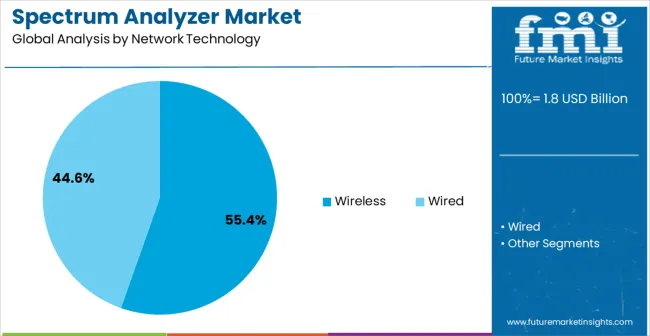
The wireless network technology segment is projected to account for 55.4% of the Spectrum Analyzer market revenue in 2025, positioning it as the leading network technology. This dominance is being driven by the expansion of wireless communication systems, including 5G networks, Wi-Fi 6, and IoT ecosystems, which demand precise spectrum monitoring. Spectrum analyzers are being increasingly deployed for identifying interference, testing signal integrity, and ensuring compliance with regulatory standards in wireless environments.
The capability to provide real-time insights into frequency distribution and bandwidth utilization is enhancing efficiency for telecom operators, service providers, and enterprises. The rise in mobile connectivity, alongside increasing adoption of wireless infrastructure in smart cities, defense systems, and industrial automation, is further strengthening the role of wireless spectrum analysis.
Technological advancements such as remote monitoring, cloud-enabled analytics, and AI-assisted diagnostics are improving usability and accuracy, thereby boosting adoption As global wireless traffic continues to grow and networks become more complex, spectrum analyzers are expected to remain indispensable in maintaining performance quality and operational reliability.
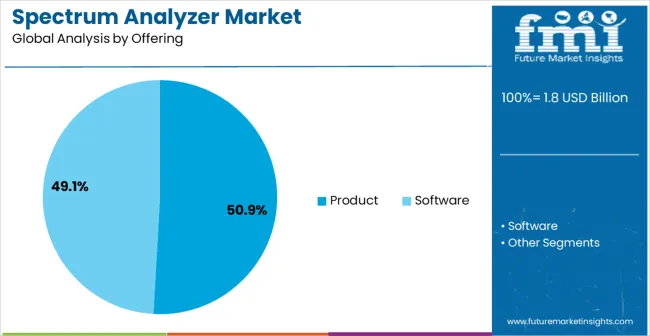
The product offering segment is anticipated to hold 50.9% of the Spectrum Analyzer market revenue in 2025, establishing itself as the dominant offering category. Growth is being supported by the increasing demand for hardware-based analyzers capable of delivering high precision and reliability in diverse operational environments. Products in this category include benchtop, portable, and handheld spectrum analyzers, each catering to specific use cases across industries such as aerospace, telecommunications, and automotive.
The widespread preference for physical analyzers stems from their durability, wide measurement range, and ability to function effectively in field and laboratory settings. Integration with advanced software for real-time analytics and data visualization further enhances their functionality, creating greater value for end users.
The scalability of product-based solutions, along with continued innovations in frequency coverage, resolution bandwidth, and measurement speed, is reinforcing demand As industries expand digital operations and face greater challenges in electromagnetic spectrum management, physical products are expected to remain the preferred choice, ensuring reliable performance, accuracy, and long-term usability.
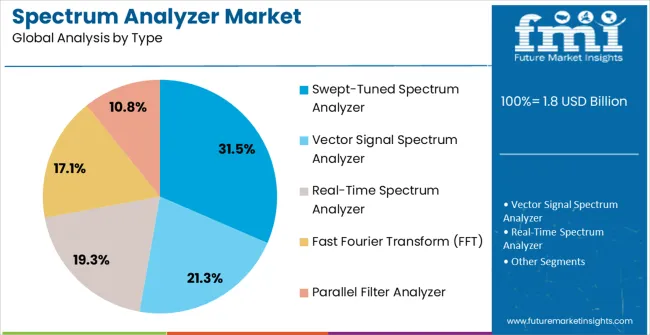
The swept-tuned spectrum analyzer type is expected to capture 31.5% of the market revenue in 2025, making it the leading type segment. Its leadership is being driven by its established reliability, wide frequency coverage, and cost-effectiveness for both research and commercial applications. Swept-tuned spectrum analyzers are widely used in telecommunications, broadcasting, aerospace, and industrial electronics due to their ability to measure power levels of signals over a defined frequency range with high accuracy.
Their compatibility with diverse testing environments and straightforward operational functionality continues to make them a preferred option for engineers and technicians. Ongoing advancements in bandwidth resolution, sensitivity, and signal processing capabilities are further enhancing their efficiency and scope of applications.
While newer types such as real-time spectrum analyzers are gaining traction, the cost advantages and proven performance of swept-tuned analyzers ensure their continued dominance As industries increasingly require reliable tools for frequency spectrum monitoring and regulatory compliance, the swept-tuned type segment is expected to retain its prominent role in driving market adoption.
Spectrum analyzers are adopted to analyze signal frequency and amplitude in logarithmic scale when the electric signal pass through the system such as real-time spectrum analyzer. Spectrum analyzers are widely adopted for manufacturing, designing and engaging in the field services and repairs electrical devices and are also used to determine performance, error detection and troubleshooting errors.
Measurement of quality of modulation is carried out for smooth transmission of data and it is crucial in both transmission and receiver end. The important characteristics of spectrum analyzer are signal to noise ratio test and noise figure test which improves overall performance of the system.
With a rising boom in telecommunication industry and increase in wave analysis, spectrum analyzer market has flourished with many new emerging players such as Keysights Technologies and LP Technologies.
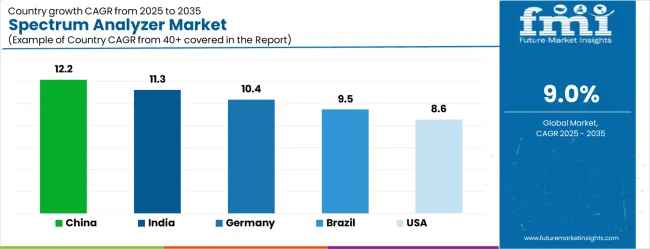
| Country | CAGR |
|---|---|
| China | 12.2% |
| India | 11.3% |
| Germany | 10.4% |
| Brazil | 9.5% |
| USA | 8.6% |
| UK | 7.7% |
| Japan | 6.8% |
The Spectrum Analyzer Market is expected to register a CAGR of 9.0% during the forecast period, exhibiting varied country level momentum. China leads with the highest CAGR of 12.2%, followed by India at 11.3%. Developed markets such as Germany, France, and the UK continue to expand steadily, while the USA is likely to grow at consistent rates. Japan posts the lowest CAGR at 6.8%, yet still underscores a broadly positive trajectory for the global Spectrum Analyzer Market. In 2024, Germany held a dominant revenue in the Western Europe market and is expected to grow with a CAGR of 10.4%. The USA Spectrum Analyzer Market is estimated to be valued at USD 670.8 million in 2025 and is anticipated to reach a valuation of USD 670.8 million by 2035. Sales are projected to rise at a CAGR of 0.0% over the forecast period between 2025 and 2035. While Japan and South Korea markets are estimated to be valued at USD 93.0 million and USD 62.2 million respectively in 2025.
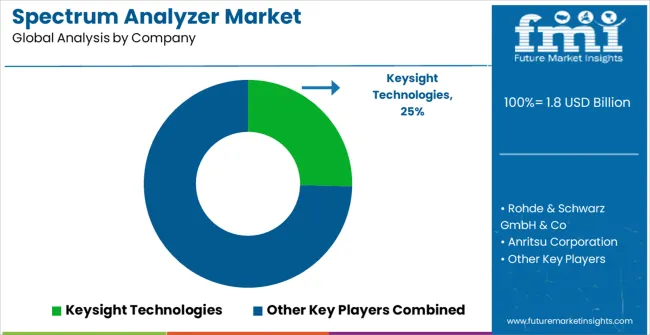
| Item | Value |
|---|---|
| Quantitative Units | USD 1.8 Billion |
| Network Technology | Wireless and Wired |
| Offering | Product and Software |
| Type | Swept-Tuned Spectrum Analyzer, Vector Signal Spectrum Analyzer, Real-Time Spectrum Analyzer, Fast Fourier Transform (FFT), and Parallel Filter Analyzer |
| End User | IT & Telecommunication, Medical & Healthcare, Semiconductors & Electronics, RF Tuning Method, Super Heterodyne, and A&D |
| Form Factor | Handheld Spectrum Analyzer, Portable Spectrum Analyzer, and Benchtop Spectrum Analyzer |
| Regions Covered | North America, Europe, Asia-Pacific, Latin America, Middle East & Africa |
| Country Covered | United States, Canada, Germany, France, United Kingdom, China, Japan, India, Brazil, South Africa |
| Key Companies Profiled | Keysight Technologies, Rohde & Schwarz GmbH & Co, Anritsu Corporation, Advantest Corporation, B&K Precision Corporation, Giga-tronics Incorporated, and National Instruments Corporation |
The global spectrum analyzer market is estimated to be valued at USD 1.8 billion in 2025.
The market size for the spectrum analyzer market is projected to reach USD 4.2 billion by 2035.
The spectrum analyzer market is expected to grow at a 9.0% CAGR between 2025 and 2035.
The key product types in spectrum analyzer market are wireless and wired.
In terms of offering, product segment to command 50.9% share in the spectrum analyzer market in 2025.
Explore Similar Insights

Thank you!
You will receive an email from our Business Development Manager. Please be sure to check your SPAM/JUNK folder too.
Chat With
MaRIA